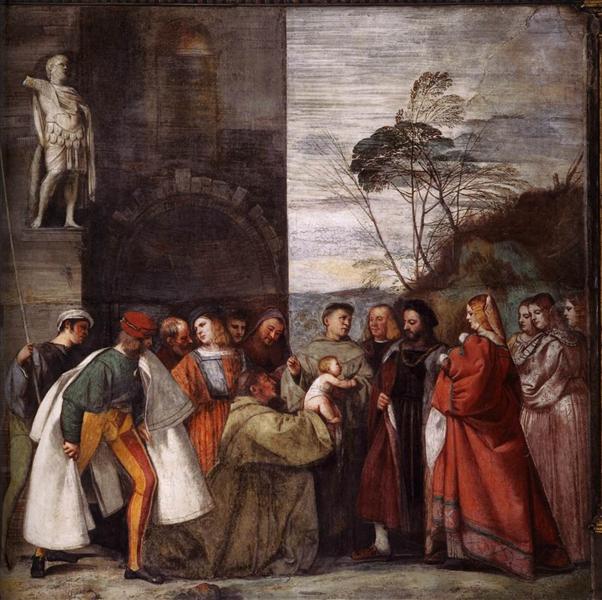Description
The Miracle of the Newborn, painted by Titian around 1511, is a moving testimony to the mastery of the Venetian Renaissance, where technical virtuosity is intertwined with a deep emotional charge. This painting inscribes a story of faith, of the fragility of life and of wonder before the sacred, elements that come together in its visual narrative. Although it is less known than other works by Titian, such as The Assumption of the Virgin, its analysis reveals a masterful display of light, color and composition, which is characteristic of the master.
Looking at the work, the scene reveals itself with a vibrant luminosity, one of Titian’s signatures, who masterfully uses colour to evoke feelings and atmospheres. The palette is composed of warm reds and golds, which fill the scene with vitality and energy. These tones contrast with the darker hues that outline the shadows and shape the characters, creating a strong play of light that makes the composition breathe. Titian manages to make each figure in the work seem almost ethereal, suggesting not only their corporeality, but also their connection to the divine world.
The scene takes place in an environment that, although not strictly defined, suggests a sense of intimacy and devotion. At the center of the composition stands the newborn, the object of devotion and wonder of the characters surrounding him. The gestures and postures of these characters are subtle, but charged with emotion. One man, who probably represents a paternal or protective figure, holds the child in his arms, while others crouch or bow in a sign of respect and wonder, creating a visual line that guides the viewer to the focus of the work. This handling of the figures resembles the tradition of religious art, where the elevation of the sacred is nuanced by the humanity of those involved.
In addition to the masterful use of color and composition, Titian also makes clever use of space. Although the scene is compact, the arrangement of characters and objects suggests an environment that nevertheless seems to open up to the viewer. Each figure is carefully placed, forming an arrangement that feels both intimate and expansive, a paradox that sparks the viewer's curiosity.
Titian's style during this period is significant. The work exudes a sense of drama and emotion that foreshadows artistic movements that would develop in the Baroque, emphasizing the interaction between figures and their emotional content. This distinctive focus on the depiction of movement and emotional expression in the human figure finds echoes in the works of Titian's contemporaries and in later artists who were also inspired by the search for the sublime in the everyday.
Although not as famous as his other works, The Miracle of the Newborn represents a fascinating example of how Titian, through his mastery of color and form, manages to capture the essence of the human experience in the face of the divine. The painting is not only a monument to technical skill, but an enduring reminder of the vulnerability of life and the wonder of creation. This fascinating dialogue between divinity and humanity continues to resonate with the contemporary viewer, making this work a valuable gem in the broader canon of Renaissance art.
KUADROS ©, a famous painting on your wall.
Hand-made oil painting reproductions, with the quality of professional artists and the distinctive seal of KUADROS ©.
Painting reproduction service with satisfaction guarantee. If you are not completely satisfied with the replica of your painting, we will refund 100% of your money.

